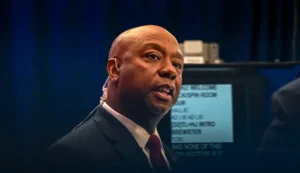Explore the intense US political landscape as we break down the potential government shutdown and the critical compromise plan. Will the US face a shutdown despite the plan? Get the essential details in this concise exploration of high-stakes drama in American politics
Despite the new compromise plan, the United States is facing the risk of a shutdown. Moody’s Investors Service warns of a potential downgrade in American credit ratings due to the shutdown (file).
Despite Speaker Mike Johnson’s new compromise plan, the threat of a government shutdown looms over the United States at the end of this week, leaving behind radical priorities such as spending cuts and reducing provisions.
The shutdown poses a risk of a downgrade in American credit ratings by Moody’s Investors Service, attributing it to political volatility as a growing risk for bond investors. Both parties will face political consequences for federal funding.

US Face a Shutdown
With funding ending after November 17, Congress has only a few days left to pass a new stopgap bill. Johnson suggested on Sunday that his plan would allow lawmakers time to negotiate on personal spending bills, a point of contention for fiscal conservatives.
He stated on social media site X, “The addiction to spending in Washington cannot be broken overnight. But I won’t let the mega-bill spending package linger under my leadership at the end of the year.”
Johnson’s plan may still face opposition from GOP traditionalists and the White House’s unified resistance, concerned about the lack of aid to Ukraine in the plan and troubled by the fact that it extends funding until January 19 for some agencies and until February for others.
The House plans to vote on the plan on Tuesday. Johnson may need some Democratic votes given his narrow majority and opposition from fiscal conservatives.
Even before the stopgap vote, they could have halted the Republican plan to come to the floor before or during procedural votes on the partisan plan.
Ohio conservative Warren Davidson stated on Saturday, “Disappointment is as humble as I can muster. I will vote ‘no’.”
Democrats are silent on Johnson’s plan, but early indications suggest it could garner bipartisan support.
Connecticut Senator Chris Murphy told NBC’s Meet the Press, “I don’t like what the House is talking about, but I’m willing to listen.”
However, the White House insists that Johnson’s plan will only lead to a shutdown in the future. President Joe Biden could issue an official veto threat later on Monday.
But the bill lacks the conditions that many Democrats feared, and a veto threat could allow Republicans to accuse the president of triggering a shutdown.
Political volatility this year has brought the United States close to default, pressured credit ratings to reduce the country’s sovereign debt, and forced Johnson’s predecessor out of his job. Republicans ousted then-Speaker Kevin McCarthy after presenting a similar string-free stopgap offer.
Moody’s, the only major credit rating agency to give the United States a top rating, turned negative on America’s credit outlook on Friday, citing the country’s fiscal strength and political polarization in Congress. The October 30 to November 7 Bloomberg News/Morning Consult poll shows that the three-week messy process of choosing a new speaker has damaged the Republican position in swing states.
With a 9-point gap, swing-state voters said the speaker’s disorder increased the likelihood of voting Democratic in 2024, saying the process made them more likely to vote Republican. Independents favored Democrats by a margin of 7 points.
The Thanksgiving holiday, starting on Saturday with the beginning of the shutdown, will grant leave to thousands of federal employees just before the holiday, delaying government contracts and payments to vendors. Soldiers, law enforcement officers, and other essential employees will continue to work, but without pay, until the impasse is resolved.

US Face a Shutdown
Financial markets have so far ignored the growing shutdown risk as investors focus on high interest rates, volatility in bond markets, reduced consumer spending, and Middle East tensions.
The economic impact of the government shutdown will be mild at the beginning but will escalate as millions of employees go without pay, private contractors remain unpaid, and consumer uncertainty increases. The University of Michigan’s consumer sentiment index dropped to a six-month low in the preliminary reading for November.
Johnson’s plan will extend existing funding for the Department of Veterans Affairs, Energy, Agriculture, Transportation, and Housing and Urban Development until January 19, with the rest extended until February 2.
In the Senate, Republicans may take steps on Monday night to prevent Democrats from moving forward on their emergency funding plan.
Senate Minority Leader Chuck Schumer of New York has prepared a procedural vote on Monday afternoon to advance the placeholder law for emergency funding, which could happen in January.
With the complexity of the emergency issue, the likelihood of reaching an agreement on a deal this week is diminishing, including the emergency security assistance sought by Biden for Ukraine, Israel, Taiwan, and the U.S. border. The Republican demands for changes in asylum and other immigration policies have derailed the package.
As we observe the developments, the possibility of reaching an agreement on any compromise this week seems low, including emergency security assistance.
US Face a Shutdown


